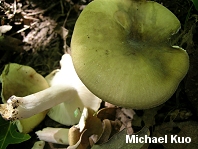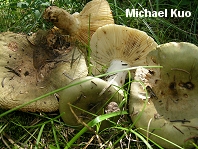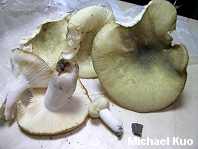Russula aeruginea (MushroomExpert.Com) (original) (raw)
Russula aeruginea
[ Basidiomycetes > Russulales > Russulaceae > Russula . . . ]
by Michael Kuo
The evenly green cap, creamy to yellowish spore print, mild taste, and slowly pink reaction to iron salts of the stem surface characterize Russula aeruginea, which is found under conifers and hardwoods across North America. Microscopic features include spores with relatively isolated warts, and a variable pileipellis that may include elongated and tapered hyphal ends and fusiform pileocystidia.
Other green russulas include Russula virescens, with a distinctively quilted cap surface; Russula olivacea, a larger species with a deep yellow to orange spore print and no pileocystidia; and uni-colored forms of the usually-mottled Russula cyanoxantha and Russula variata--both with white spore prints. Additionally, none of these species demonstrates a pink reaction to iron salts.
Description:
Ecology: Mycorrhizal with hardwoods or conifers; growing alone, scattered, or gregariously; summer and fall; widely distributed in North America.
Cap: 5-9 cm; convex when young, becoming broadly convex to flat with a shallow depression; dry or slightly moist; smooth, or minutely velvety over the center; grayish green to yellowish green; the margin often lined by maturity; the skin peeling about halfway to the center.
Gills: Attached or running slightly down the stem; close; often forking near the stem; creamy to pale yellow; sometimes becoming spotted brownish in places.
Stem: 4-6 cm long; 1-2 cm thick; whitish; dry; smooth; discoloring brownish in places, especially near the base.
Flesh: White; brittle; not changing when sliced.
Odor and Taste: Odor not distinctive; taste mild.
Chemical Reactions: KOH on cap surface orange. Iron salts on flesh and stem surface slowly pink.
Spore Print: Creamy to pale yellow.
Microscopic Features: Spores 6-8.5 x 5-7 µ; with isolated warts up to .8 µ high; connectors scattered, usually not forming reticula. Pileipellis a cutis beneath a turf-like upper layer of elements that are often septate, with subterminal cells inflated and barrel-shaped and the terminal cell clavate, cylindric, or (as illustrated) elongated and tapered; pileocystidia clavate to fusiform, up to about 75 x 10 µ, positive in sulphovanillin and refractive-ochraceous in KOH.
REFERENCES: Fries, 1863. (Saccardo, 1887; Burlingham, 1915; Kauffman, 1918; Shaffer, 1970; Smith, 1975; Smith, Smith & Weber, 1979; Weber & Smith, 1985; Arora, 1986; Kibby & Fatto, 1990; Lincoff, 1992; Metzler & Metzler, 1992; Horn, Kay & Abel, 1993; Evenson, 1997; Thiers, 1997b; Barron, 1999; McNeil, 2006; Roberts, 2008.) Herb. Kuo 08160602, 07230804, 08140803.
This site contains no information about the edibility or toxicity of mushrooms.
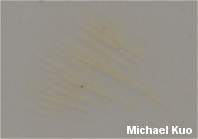
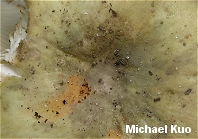
KOH
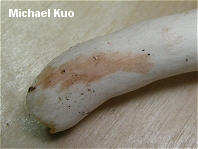
Iron Salts
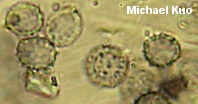
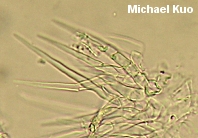
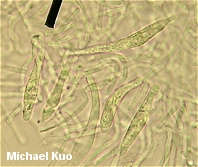
© MushroomExpert.Com
